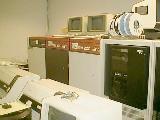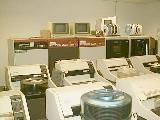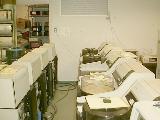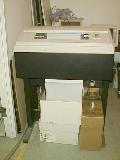Moving Old Iron - A Series
Move Report - KS10 Mainframe(s)
Containing methods and hints
by
Megan Gentry
Updated May 12, 1999
See also: PDP-8s and PDP-11/34a
Abstract
This paper is one of a series which document the tools, techniques and procedures which have been successfully employed to move old computer systems for purposes of collection and restoration. It is also used to document the restoration process.
Background
I was recently contacted by a representative of the Strategic Planning Institute, located in Cambridge, Mass. I was informed that the company owned a 20-year-old decsystem-10 computer system that they were going to be retiring soon. An old friend of mine had done work for them and had remembered that I was interested in acquiring a PDP-10 of some sort, so he pointed them to me. They asked me if I was really interested. I told them I was, but I needed some more information about the system to determine if I had room at home or if I would have to temporarilly store it.
 When I actually talked with the representative, I found out that not only did they have one system -- they had *three* KS10 systems. One was currently in commercial operation, one had been taken off-line just a few months earlier, and the last one was an unknown.
When I actually talked with the representative, I found out that not only did they have one system -- they had *three* KS10 systems. One was currently in commercial operation, one had been taken off-line just a few months earlier, and the last one was an unknown.

There were also two TU77 tape drives (seen at the far right, back), one of which is visible in the above photo, adjacent to the KS10s,

ten RP06 220Mbyte disk drives,

and two line printers.
But there was a catch -- the company had a finite amount of time to move the systems, so they were requiring that ALL of the hardware had to be taken at one time or that none of it could go. They did not want to have the machines taken piece-meal. And if the machines were not taken, they would be sent to the a) crusher, b) landfill, or c) (imagine some suitibly horrible fate for old machinery here).
Unfortunately, I didn't have the room in my home (due to a recent haul of hardware
which you can read about here)
for one machine, let alone three (and the tapes and disks and printers and terminals...) so I had to find others interested in part of the haul.
With this information, I posted a call to arms to the
Classic Computer Collector's Mailing List
explaining the situation and asking if anyone was interested in a PDP-10 or interested in helping with the move. I also posted the same message to
alt.sys.pdp10
and to a private mailing list for techno-oriented people (who are into theatrical tech, network tech, science fiction and anything-tech).
I received mail from about 20 people, some of whom were interested in part of the hardware, some who were willing to help, and some who were interested bystanders. I kept track of the order in which people contacted me, so that there would be a somewhat fair and equitable way of deciding who could get what. It took a few weeks worth of Email exchanges, but we finally determined who was going to get what systems, tapes and disks, and who would be available to help.
I then started being the liason between the list and the company. I made several trips to the company to examine the hardware, measure systems and plan when things needed to be done.
A note to anyone considering doing the same thing -- decide in advance how the hardware is to be allocated to volunteers, and make it clearly known. I kept track of the order in which people contacted me, and on how much hardware they were interested in, and most importantly if they were willing to assist in the actual move. When one party was unable to take the hardware they originally planned to, it was easy to go down the list until I found a party who was willing to take the equivalent amount.
Planning and equipment needed
The following equipment was used in preparing for, and accomplishing the move:
- Hex Wrenches - used for the front and rear doors of the CPU and TU77 cabinets
- Crescent Wrenches - use to remove the nuts and bolts holding the CPU racks together. Also used to raise the stabilizing feet on the CPU, TU77 and RP06 cabinets.
- Screwdrivers - flat and phillips, various sizes, used to remove bolts holding the racks together.
- Cable Ties - used to secure the machine keys in the cabinets and to secure the coiled cabling.
- Masking tape - to mark various cables
- Strapping tape - to tape closed doors without latches, like those on the RP06s which are normally only held closed with magents or pressure latches.
- Digital Camera - to record the process and to document cabling
- Voice Recorder - to take notes about the configuration
- Webbing - used to secure the cabinets to the walls of the trucks
- Rope - to be used if we ran out of webbing.
- Dollies - used to move objects without wheels (such as the printers and some printing terminals
Additionally, the building management at the site had to be informed of the move in advance so they could be prepare the building, and they had the following ready:
- Sheets of fiber-board - to lay on the carpet so that the objects we were rolling would not damage the carpet. Also useful to bridge the gap at the threshold to the elevators.
- Padding placed on the elevator walls - to protect against damage
In order to select a truck of sufficient size to accomodate all the equipment we needed to move, we needed to measure the 'footprint' of all the items which would end up in the truck. On one of my trips to SPI, I made note of the dimensions of all the racks and cabinets. None of the racks were taller than 60", so a truck with a 7' inside clearance would be fine. Based on the sizes of the racks and cabinets, I figured we needed truck(s) which could handle at least 138 sq.ft. The 15' truck was too small (117sq.ft. or so). The next one up was a 24ft.
Our next problem was that the hardware was not all going to the same place, and there was some question building as to who was going to get the systems -- one group had to back out at the last minute because they determined they really didn't have the room, so we ended up with two trucks -- one taking a system up north to Nashua, NH, and the other to take two systems south to the Rhode Island Computer Museum (who are kindly providing space for my system).
So, we had two trucks. This was advantageous because on the actual day of the move, we found out that the company had even more stuff that they were willing to get rid of -- old (OLD) IBM PCs, terminals, spare PC boards, disks, tapes, etc... They basically wanted the room cleared as much as possible.
A sad note about the machines
The systems had been cared for for years by someone whose health began to fail last year (1998). A few days before his death last year, he made a final trip to the machine room to say goodbye to people and to the systems. On the day he died, as if in sympathy, the systems all crashed. It took a fair amount of work, apparently, to get them back up and running. My old friend was part of that effort, and was also the one who provided me with this personal note about the systems.
Preparing the systems for the move
After some discussion with SPI, it was decided that the system would be taken down for the last time on Wednesday, the 23rd of April. The person who was my contact at SPI, Anna, was also the acting system manager. She began preparing the system disks on monday, taking the system down to prepare disks which did not have the company's data on them. But she immediately began getting calls from Europe, where there were people who decided that they hadn't finished doing their backups and still needed the system, so she brought the system up long enough to let them finish.
With the backups done, Anna took the system down again and she and my friend worked on preparing the bootable disks for our use when we got the systems back together. When they were done, they brought the system back up with the real system disks, which is what they were running from on Wednesday the 21st when I arrived to attend the final shutdown. It was a sad time for the people at SPI, but they were gladdened to know that the systems would have continued life somewhere. I took a few pictures of the final SYSTAT screen at the CTY. Then Anna pressed the keys which got the CTY into console mode, and the system was taken down.
They removed their system packs, and we mounted one of the system packs they were providing to me. It booted fine, and we shut the system down for the last time at SPI.
I then began the process of going around to all the cabinets -- KS10s, TU77s and RP06s, and turning off all breakers. Once they were off, I started following power cables from the CPU and TU77 cabinets to the wall, and unplugged them. The cables were rolled up and placed into the cabinets for moving.
The next step was to determine the connections between cabinets. The KS10 cabinets were bolted together, with only the first and last cabinets having the 'skins'. I found the bolts and removed them, saving them for later. I then started tracing cables to see what sorts of inter-cabinet connections there were.
KS10 systems generally have the KS10 backplane and an RH11 in the bottom front of the cabinet, and a BA11 box (like one you might find in a PDP-11) in the rack above it. There are a set of cables which attach an adapter (UNIBUS Adapter #1) in the KS10 backplane to the RH11 beside it, and a second set of cables which attach a second adapter (UNIBUS Adapter #3) to the UNIBUS (possibly containing a second RH11) in the BA11. But the machines at SPI had been cross-connected with the UBA#3 in the first KS10 attached to the BA11 box in the second KS10, the
UBA#3 in that box attached to the BA11 box in the third KS10, and the UBA#3 of that box connected to the BA11 in the first box. We suspect that this was done because the person wanted to avoid actually moving BA11 boxes around, but needed options (extra DZ11s and an RH11) in another machine. So I made note of what went where, but then connected each KS10 to its own BA11 box.
The next step was to disconnect the thick Massbus cables (almost 1.5" thick pipes) which connected the systems to the RP06s and the TU77s.
The systems were connected to a TYMNET switch through DZ11s, and all those connections had to be removed. Fortunately, they were standard 25-pin RS232 connectors which were simply plugged in, not anchored with the screws. So all I had to do was pull them out of the DZ line distribution panel (but there were almost 80 lines spread across the three CPU cabinets and it took some work to snake them all out).
The final step for preparing the CPU cabinets was to raise all the steadying feet. With this done, each cabinet was free to move separately (at this point we found that the room was canted a little, as it took very little energy to push them in one direction, while it took a fair amount more to push them the other direction.
With the CPU cabinets done, I turned my attention to the TU77 cabinets. Again, power cables and Massbus cables were removed. There were no bolts holding the cabinets together -- they were already free to move.
This was the end of the first day of pre-staging. The major prestaging day had been scheduled for April 23rd. I had 5 people who had confirmed that they would be there to help.
More to come in the next edit!
 Validate Now!
Validate Now!
Return to [ HOME ] page.
This page developed and Copyright © 1999 by
Megan Gentry, All Rights Reserved.
 When I actually talked with the representative, I found out that not only did they have one system -- they had *three* KS10 systems. One was currently in commercial operation, one had been taken off-line just a few months earlier, and the last one was an unknown.
When I actually talked with the representative, I found out that not only did they have one system -- they had *three* KS10 systems. One was currently in commercial operation, one had been taken off-line just a few months earlier, and the last one was an unknown.


